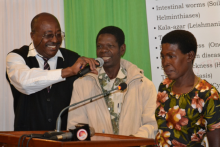Kenya launches Neglected Tropical Diseases (NTDs) Master Plan 2016-2020
Nairobi, June 2016 - Kenya launched the second Neglected Tropical Diseases (NTD) Master Plan 2016 - 2020 on 15 June 2016. Present at the launch were senior government officials, representatives of Non -Governmental Organizations (NGOs), the UN, academia, research institutes, Civil Society, the media, people affected by NTDs and several other stakeholders collaborating with the Kenyan government to combat the NTDs in Kenya.
The key guests who presided over the launch were Dr Jackson Kioko, Ag. Director Medical Services, Ministry of Health, Dr Nathan Bakyaita, Officer in charge ( OIC) WHO country office, County Directors of Health from the 47 Counties in Kenya, Country Representatives, Helen Keller International, CBM, Sight Savers International and Evidence Action, among others. The Ag Director of Medical Services represented the Cabinet Secretary, Ministry of Health at the occasion.
In his opening remarks Cabinet Secretary for health represented by the Ag. Director, Medical Services, Dr Jackson Kioko, stated that Kenya will no longer accept NTDs as being neglected or associated with the poor especially with government’s Vision 2030.
He implored the partners and stakeholders to be sufficiently motivated to ensure that the NTDs are eliminated. He reiterated that this could be achieved with galvanized effort and resources using synergies from all partners and stakeholders to ensure key NTDs are eliminated by 2020. He commended the Ministry of Health for the establishment of an inter-agency committee on NTDs( NTD-ICC) and stated that elimination of NTDs is a national priority. He further added that the Cabinet Secretary recognized the development of the 2nd NTDs Strategic Plan as part of government’s committed effort to alleviate the suffering of the poor since NTDs mostly affect the poor. He urged everyone to contribute to raising the level of public awareness in the communities.
He appealed to all stakeholders to join the Government in raising their voices in support for elimination of NTDs, and embrace a change in mindset as this was a task to be achieved through collective efforts. The Cabinet Secretary stated that the Ministry of Health aims at reducing the 17 NTDs currently prevalent in Kenya to at most three by the end of this strategic plan.
On Guinea Worm Disease, the Cabinet Secretary stated that government will do everything to ensure that Kenya is certified Guinea Worm Disease free by September, 2016. He stated that GWD will not be on the Kenya list of NTDs after the certification in 2016. He stressed that GOK is committed to ensuring that this in line with their pledge at the World Health Assembly in May 2016. He promised that Government will give the necessary support to attain the 2020 NTDs targets.
Speaking at the launch, Dr Nathan Bakyaita OICWHO Kenya re-affirmed WHO’s commitment and support to the government of Kenya and stakeholders to eliminate NTDs in Kenya and contribute to poverty alleviation, productivity and improved quality of life of the people affected by NTDs in the African region. He stated that the plan aligns national interventions, objectives and goals with the global WHO NTDs road map to NTD elimination by 2020. He reiterated that implementation of the plan will ensure that the NTDs will henceforth be “non-neglected” diseases.
Key highlights of the event were a documentary which showed the NTDs prevalent in Kenya and the negative impact they have on the society as well as testimonies from people affected by NTDs. The most spectacular testimony was given by Mr and Mrs Katana, who are beneficiaries of the NTD control programme intervention . Mr Katana from Kilifi County had suffered from hydrocele due to Lymphatic Filariasis and was ostracized in the society as he could no longer fend for his family. His wife had almost left him. The extended family and friends had lost hope and said he should stay home and die, believing it was incurable since it was resulting from witchcraft.
Eventually, he approached the NTD program who arranged for him to have a hydrocoelectomy after 15 agonizing years with the condition. He stood in front of the audience with his wife to testify about the benefits of NTDs control activities and his new lease of life, that included having another child, a fit deemed impossible while he suffered from a massive hydrocele.
The revised Master plan which is a road map for the control, elimination and eradication of NTDs comprises of three parts with a particular focus on subnational implementation in line with the prevailing epidemiology. This is expected to strengthen linkages between the health system and communities and also facilitate and promote ownership and sustainability of the programme. The Plan is aligned with the Kenya Health Strategic Plan, Vision 2030, the Kenyan Constitution, Sustainable Development Goals, WHO Guidelines on NTDs elimination and the global road map for NTD elimination. The document provides information on the situation analysis of NTDs in Kenya, epidemiology of the diseases, gaps and priorities for the elimination of the diseases in Kenya.
The strategic goal of the Master plan is “Accelerating the reduction of the disease burden through control, elimination and eradication of targeted NTDs and contribute to poverty alleviation, increased productivity and improved quality of life of the affected people in Kenya”.
The guiding principles are:
- Strengthen government ownership, advocacy, coordination and partnership
- Enhance planning for results, resource mobilization and financial sustainability
- Scale up access to interventions, treatments and system capacity building
- Enhance NTD monitoring and evaluation, surveillance and operational research
The third part of the document covers the operational framework which includes plans for scale up of activities in the next 5 years to ensure all eligible persons access interventions regardless of age. Moreover, the interventions should be combined with other complementary NTDs prevention strategies. The plan will ensure that NTDs medicines remain safe, through pharmaco-vigilance and improved accessibility and coverage of NTD interventions in and integrated and coordinated manner, while embracing a multisectoral approach towards making Kenya a nation free of NTDs!.
The plans is anchored on the June 2012 Accra Declaration on elimination of NTDs, and is in line with WHA 66.12 resolution to eliminate NTDs. The document covers a five year period, and is expected to promote integration and effective coordination of activities to eliminate NTDs in Kenya. The plan incorporates an end-term evaluation after the five year period as well as a section on resource mobilization.
In his concluding note, Dr Kioko commended the Katanas who have demonstrated that it is possible to live a healthy life free of NTDs and suffering, and also virtue of patience. He appealed to the County governments to prioritise the NTD Programmes at the county levels. He therefore declared the Revised NTD Strategic Plan 2016-2020 officially launched.
__________________________________
For further information, please contact:
Dr Joyce Onsongo, DPC WHO Kenya
WHO, Kenya Country Office, 4th Floor
ACK Garden House, 1st Ngong Avenue Off Bishops Road
P.O. Box 45335, 00100(GPO); Nairobi, Kenya
Email: afkenwr [at] who.int (afkenwr[at]who[dot]int) or Onsongoj [at] who.int (Onsongoj[at]who[dot]int)










